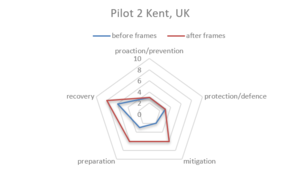Implementation process
By looking at the the activities, actors and methods/approaches used, this section will provide a better understanding of the the implementation process of the MLS approach. We will look describe the point of departure, describe who was involved (when, why and how) and what key decisive moments there were.
Point of departure of FRM strategies
The desired score to reach per layer in the Kent pilot (Baseline monitor Kent, 2019).
Stakeholders involved
- Kent County Council
- Kent Fire and Rescue
- Kent Police
- National Health Service (NHS)
- Public Health England
- Members of the Kent Resilience Forum (KRF)
- The 12 Districts and Borough councils across Kent (Ashford Borough Council, Canterbury City Council, Dartford Borough Council, Dover District Council, Folkestone and Hythe District Council, Gravesham Borough Council, Maidstone Borough Council, Sevenoaks District Council, Swale District Council, Thanet District Council, Tonbridge and Malling Borough Council and the Tunbridge Wells Borough Council)
- Medway Unitary Authority
- UK Environment Agency
- Service providers
- Front line services
- Residents
Roles of key actors
The UK Environment Agency (EA) is the lead authority in case of river flooding and, in this role, they collaborate with other responsible agencies to warn and inform the public of the risks, impacts and the actions that they could take to alleviate those impacts.
Kent County Council (KCC) is the Lead Local Flood Authority responsible for drainage on the highways and surface water flooding. The council is a Category 1 responder under the Civil Contingencies Act 2004 and as such has a role in emergency planning and responding to flooding events. The duties of the KCC during a flood event are (Kent County Council, 2017):
- Assess the risk of surface water flooding;
- Put emergency plans in place;
- Ensure that there is business continuity management in place;
- Respond to flooding when it happens, along with EA and all the other agencies involved in the immediate response to a flood event;
- Warn and inform the public about the risks, the impacts and the actions that they could take if they want to alleviate those impacts;
- Share information;
- Co-operate with other organizations to manage the risk.
The Civil Contingencies Act 2004 requires KCC to work together with other Category 1 and 2 responders as part of the Kent Resilience Forum (KRF). The organisations specified under the Act, are required by law to work as part of the KRF to respond to emergency events, including flooding. Members of the KRF hold different levels of responsibility during an event and include: the Highways Agency, UK Power Networks, BT, MCA, Southern Water, South East Coast Ambulance Service, Public Health England, Vodafone, South East Water, Medway Council, the National Health Service, the Environment Agency, Southern Gas Networks, Affinity Water, National Grid, Network Rail, Kent Police, and the Kent Fire and Rescue Service.
The Kent Resilience Forum (KRF) is a local resilience forum, of which there are 43 across the UK and is responsible for coordinating the activities before, during and after a flooding event. KCC emergency planners lead on the preparation for an event, while Kent Police co-ordinate the immediate response to an event, and KCC take a lead on public service recovery from an event once the initial response has been completed. KCC is part of the Kent Resilience Forum (KRF) at different levels. Senior staff are part of coordinating groups who provide strategic direction of the response to an event. Operational staff are on the front line of the response to an event (interview pilot managers, 2019).
The Kent Resilience Team is a steering group comprised of staff from Kent County Council, Kent Fire & Rescue Service and Kent Police. Their role is to coordinate the activities of the different parties in the KRF, considering the local priorities in relation to response and immediate recovery (risk assessment and planning).
The role of KCC during the FRAMES pilot is to facilitate the process of increasing flood resilience in the health & social care sector, engage with the right stakeholders and make sure that reasonable steps are being taken to prevent, respond to and recover from flooding. After the pilot project is finished, KCC will continue working with the identified at risk health and social care assets, raising awareness and providing guidance to improve their preparedness for floods and other climate hazards including high temperatures and heatwaves (interview pilot managers, 2019).
Referenties
- Flooding in England: A National Assessment of Flood Risk, EA, EA, 1 januari 2009.
- Transnational Monitor and Evaluation report FRAMES, FRAMES, FRAMES, 8 juni 2020.
- Community Flood Vulnerability and Disadvantage in Kent and Medway, Kent County Council, Kent County Council, 1 juli 2019.
- Flood Risk to Health and Social Care Infrastructure in Kent and Medway, Kent County Council, KCC, 1 juli 2019.
- Flood response plan Kent, Kent County Council, KCC, 1 juli 2017.
- HZ Kent presentation 2019, Kent County Council, Kent County Council, 1 juli 2019.
- Monitoring survey 2 Kent FRAMES, Kent County Council, 1 september 2019.
- Kent Resilience Forum, Kent Resilience Forum, 9 september 2019.

